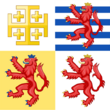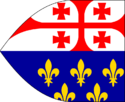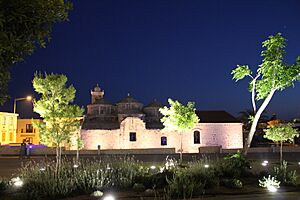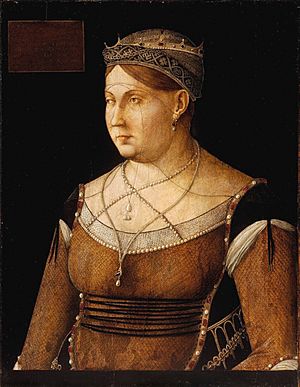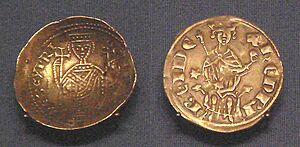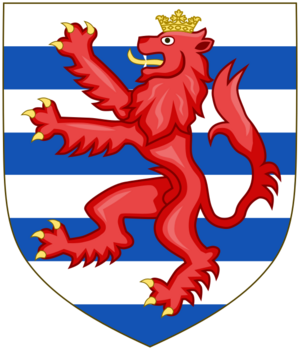Kingdom of Cyprus facts for kids
Quick facts for kids
Kingdom of Cyprus
|
|||||||||||||
|---|---|---|---|---|---|---|---|---|---|---|---|---|---|
| 1192–1489 | |||||||||||||
|
Top: Royal banner of
Janus of Cyprus (15th century) Bottom: Flag according to Book of All Kingdoms (1350) |
|||||||||||||
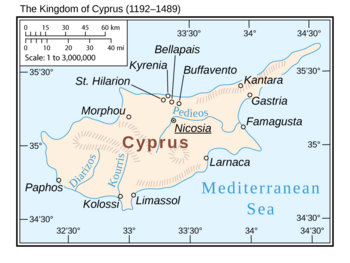
Cities of medieval Cyprus (1192–1489)
|
|||||||||||||
| Status | Independent Christian kingdom (1192–1198/1268–1372) Tributary state of the Armenian Kingdom of Cilicia (1198–1229) Tributary state of the Holy Roman Empire (1229–1268) Tributary state of the Republic of Genoa (1372–1426) Tributary state of the Mamluk Sultanate (1426–1489) |
||||||||||||
| Capital | Nicosia | ||||||||||||
| Common languages | Latin (official/ceremonial) Greek (native language) Old French (popular) Italian French Arabic Armenian |
||||||||||||
| Religion | Catholic Christianity (State religion) Greek Orthodox Christianity (popular) |
||||||||||||
| Government | Feudal monarchy | ||||||||||||
| King | |||||||||||||
|
• 1192–1194
|
Guy of Lusignan (first) | ||||||||||||
|
• 1474–1489
|
Catherine Cornaro (last) | ||||||||||||
| Legislature | Haute Cour | ||||||||||||
| Historical era | Middle Ages | ||||||||||||
|
• Established
|
1192 | ||||||||||||
|
• Disestablished
|
1489 | ||||||||||||
| Currency | French denier, gros | ||||||||||||
|
|||||||||||||
| Today part of | Cyprus | ||||||||||||
The Kingdom of Cyprus (French: Royaume de Chypre; Latin: Regnum Cypri) was a powerful Christian kingdom during the Middle Ages. It existed on the island of Cyprus from 1192 to 1489. This kingdom was one of the Crusader states, which were Christian states set up in the Middle East during the Crusades.
The kingdom was founded by the French House of Lusignan after the Third Crusade. For most of its history, it was an independent Christian kingdom. It controlled the entire island of Cyprus. Sometimes, it also held small areas on the mainland of Anatolia, like Antalya and Corycus.
Contents
History of the Kingdom of Cyprus
Early History of Cyprus
After the Roman Empire split into two parts, Cyprus became part of the Byzantine Empire (the Eastern Roman Empire). The island's Christian leader, its bishop, became independent from other major church leaders in 431 AD.
Around 650 AD, Arab Muslim armies invaded Cyprus. However, in 688, the Byzantine emperor and the Arab caliph made a unique agreement. For the next 300 years, both groups ruled Cyprus together. This was called a condominium. Even with wars happening on the mainland, this shared rule mostly continued on Cyprus.
In 965 AD, the Byzantines fully regained control of the island. Later, in 1185, a Byzantine governor named Isaac Komnenos of Cyprus rebelled and took control of Cyprus for himself. He even tried to become emperor. The Byzantines tried to stop him, but he had help from the King of Sicily.
Richard the Lionheart Conquers Cyprus
In 1191, King Richard I of England, also known as Richard the Lionheart, was on his way to the Third Crusade. A storm scattered his fleet near Cyprus. Three of his ships sank near Limassol. The survivors were captured by Isaac Komnenos.
When a ship carrying Richard's sister and his future wife arrived, Komnenos refused to let them land. King Richard soon arrived with the rest of his fleet. Hearing about the captured sailors and the insults to his family, Richard decided to fight Komnenos. There were rumors that Komnenos was secretly working with Saladin, the Muslim leader, to protect himself from his enemies.
Controlling Cyprus would give King Richard a very important base for the Crusades. The English army fought the Cypriots on the shores of Limassol. Richard's archers and armored knights were very strong. Komnenos escaped to the hills, but Richard tracked him down and attacked his camp. Komnenos escaped again.
The next day, many Cypriot nobles swore loyalty to King Richard. Komnenos, fearing betrayal, fled to a stronghold. After Richard's wedding in Limassol in May 1191, Komnenos tried to escape by boat but was caught. He was imprisoned and died shortly after.
King Richard then continued his journey to Acre in the Holy Land. He left soldiers in Cyprus and put Richard of Canville and Robert of Thornham in charge. Richard took property from those who fought him. He also made Cypriot men shave their beards. A relative of Isaac's led a rebellion, but it was quickly stopped.
The Knights Templar Rule Cyprus
King Richard soon realized that holding onto Cyprus was difficult while fighting in the Holy Land. So, he sold the island to the Knights Templar for a large sum of money. The Knights Templar were a famous military order known for their wealth.
However, the Templars ruled Cyprus very strictly, which made the local people angry. On Easter Day in 1192, the Cypriots tried to attack and kill their Templar rulers. But the Knights knew about the plan and took shelter in their stronghold in Nicosia.
The Cypriots then surrounded Nicosia. The Templars, seeing how serious the situation was, suddenly attacked the Cypriots at dawn. This surprise attack led to a brutal fight. The Templars won, but they no longer wanted to rule Cyprus. They asked King Richard to take the island back.
Richard agreed, and the Templars returned to Syria, keeping only a few properties on Cyprus. Most of the Roman Catholic population on the island lived in coastal cities like Famagusta and the capital, Nicosia. The Orthodox Christian Cypriots mostly lived in the countryside. The independent Cypriot Orthodox Church was allowed to stay, but the Catholic Church became more powerful.
The Lusignan Kings of Cyprus
Meanwhile, Guy of Lusignan, who had been King of Jerusalem, lost his claim to that crown. Since Guy was a friend of King Richard, Richard offered him the Kingdom of Cyprus. This allowed Guy to keep some power in the East. It's not clear if Richard gave or sold Cyprus to Guy, or if he was ever paid.
In 1194, Guy of Lusignan died without children. His older brother, Amalric, became King Amalric I of Cyprus. His title was approved by the Holy Roman Emperor.
After Amalric's death, the kingdom was often ruled by young boy kings. The powerful Ibelin family acted as regents, meaning they ruled until the kings were old enough. In 1229, Frederick II, Holy Roman Emperor, tried to take control, bringing a conflict from Europe to Cyprus. His supporters were defeated by Cypriot forces in 1232 at the Battle of Agridi.
Later, in 1268, Hugh III of Cyprus also became King of Jerusalem, uniting the two kingdoms. However, the land in Palestine was lost in 1291. Even so, the kings of Cyprus continued to claim the title of King of Jerusalem.
How the Kingdom Was Governed
Like Jerusalem, Cyprus had a Haute Cour (High Court). This was a council of nobles who advised the king. However, the king in Cyprus was richer and had more personal power, so he didn't always need to listen to the court. The House of Ibelin was a very important noble family.
The kings often had conflicts with Italian merchants. After the fall of Acre in 1291, Cyprus became a major center for trade between Europe, Africa, and Asia. This made the island very important for merchants.
In the 14th century, merchants from Genoa (an Italian city) became very powerful in Cyprus. The kingdom eventually became a tributary state to the Mamluks in 1426. This meant Cyprus had to pay tribute to the Mamluks and lost much of its independence. Finally, in 1489, the last queen, Catherine Cornaro, was forced to sell the island to Venice.
Economy and Trade in Cyprus
During the Lusignan period, Cyprus's economy was mostly based on farming. However, the island also became a very important trading hub. It connected Western Europe with the Middle East. This led to a high demand for Cypriot products, especially sugar, but also wine, wheat, and olive oil.
This made Cyprus much richer than it had been before. The port city of Famagusta and the capital, Nicosia, grew a lot. Many impressive buildings were constructed during this time. Other towns like Limassol also played a role in trade. Limassol became a key port for exporting farm products and a stop for Christian pilgrims.
The wealth attracted people from Europe (like Genoa and Venice) and Syria to Cyprus. These new residents, especially Latins, worked as merchants, craftspeople, and ship captains. They played a big part in the economy.
New industries also started in Cyprus. Cypriot pottery became unique and was exported. In the late 1200s and early 1300s, the textile industry grew. New workshops for dyeing fabrics opened in Nicosia. Fabrics from Cyprus became popular in both the West and the East. Famagusta also became a center for shipbuilding.
The growth of industries and the need for workers in sugar and wine production led to a demand for slaves. Slave markets existed in Nicosia and Famagusta.
Society and Culture in Cyprus
The society in Cyprus during the Lusignan period was made up of many different ethnic groups. Most of the people were Orthodox Greek Cypriots. They lived mainly in the countryside, working as farmers. The population grew until the mid-1300s. However, the Black Death plague in 1347-48 caused a huge loss of life, killing about a quarter to a third of the population. Repeated outbreaks prevented the population from fully recovering.
The Roman Catholic Latins were a smaller group, never more than a quarter of the island's population. They mostly lived in the cities. French knights and nobles lived in Nicosia, while Italians were mainly in Famagusta. After the Crusader states in the Levant were lost, many Latin immigrants moved to Cyprus.
Other groups like Maronites, Armenians, and Syrians lived in the foothills and coastal areas. There was a system where different ethnic groups had different social standings. However, since Greeks were the majority, the Frankish nobility allowed them some self-rule. For example, Greek church courts could operate.
The Greek Cypriot dialect was the common language spoken on the island. Legal texts were even translated into Greek. This level of freedom meant there were no major ethnic rebellions during the Lusignan period. While some Greek historians have seen a peasant revolt in 1426-27 as a national uprising, it was more a series of riots by Greek peasants and mercenaries after a Mamluk invasion.
Kings and Queens of Cyprus
The Kingdom of Cyprus was ruled by the House of Lusignan. Here are some of its most important rulers:
- Guy (1192–1194) - The first King of Cyprus.
- Aimery (1194–1205)
- Hugh I (1205–1218)
- Henry I (1218–1253) - Known as "the Fat."
- Hugh II (1253–1267)
- Hugh III (1267–1284) - Known as "the Great." He also claimed the title of King of Jerusalem.
- John I (1284–1285)
- Henry II (1285–1324)
- Amalric of Tyre (1306–1310) - Served as regent during Henry II's reign.
- Hugh IV (1324–1358)
- Peter I (1358–1369)
- Peter II (1369–1382) - Known as "the Fat."
- James I (1382–1398)
- Janus (1398–1432)
- John II (1432–1458)
- Charlotte (1458–1464) - She ruled with her husband, Louis of Savoy, Count of Geneva.
- James II (1460/1464–1473) - Known as "the Bastard."
- James III (1473–1474)
- Catherine Cornaro (1474–1489) - The last queen of Cyprus.
Titles Held by the Kings of Cyprus
The Kings of Cyprus often held other important titles, showing their power and claims:
- King of Cyprus
- King of Jerusalem
- Lord of the Mountains (referring to the Armenian Kingdom of Cilicia)
Images for kids


